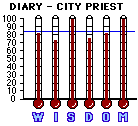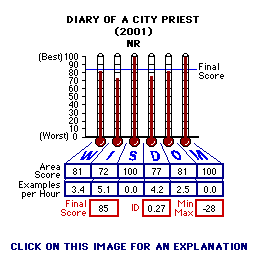


Click on CAPCon Alert image for explanation |
A service to our youth through you, their parents and grandparents, in His name by His Word MAR22SP10 Diary of a City Priest (2001), NR Analysis Date: November 19, 2002 CAP Score: 82 CAP Influence Density: 0.32 MinMax: -38 |
 |
 NO service charges. All donations are tax deductible. | To subscribe to (or unsubscribe from) our FREE text-only versions of our Entertainment Media Analysis Reports as they are calculated, visit our Mailman. If you experience difficulty with Mailman, send us your request. Your email address will NOT be given or sold to other parties. |

DIARY OF A CITY PRIEST (NR) -- ...solicitous of deep thought, reflection and empathy. Production: City Story Pictures, Independent Television Service Director(s): Eugene Martin Producer(s): Ed Givnish, Eugene Martin, Lisa Rosenstein, Cate Wilson Written by/Screenplay: Eugene Martin, Father John McNamee (book) Cinematography/Camera: Michael Pearlman Music: Matthew Levy Casting: Susan Shopmaker Film Editing: Eugene Martin, Juli Vizza Sound Mixing: Brian Miksis Production Design: Robert Holtzman Father John P. McNamee (David Morse) has been a Priest for 24 years at St. Malachy's parish in North Philadelphia. Inner city North Philadelphia presents an endless string of poverty-stricken people needing help, criminals wanting help and little help be had. Most of the help they get seems to come from or through Father McNamee. While Diary of a City Priest seems dark and empty of energy, it definitely is not evil. It is rather solicitous of deep thought, reflection and empathy. Despair, regret, doing the work nobody dares or cares about is taking its toll on Father McNamee. This is a drama based on the book of the same name written by the real Father McNamee. Writer/Director Eugene Martin adapted the book into this serene narrative film. The sad, tired eyes and the care-worn face of David Morse makes him perfect for the part. Some reviews claim this is a story about the day-to-day woes and depression of an inner city priest struggling with worth as a priest and with his faith. What I saw was portrayal of a man of God struggling with struggles but not with his faith. Rather with the demands of it. The viewer gets the impression that Father McNamee would blow at any time, but he didn't. He kept going. Kept giving. And kept getting the help the people needed. While the price on himself was heavy, Father McNamee was clearly willing to pay it with little bickering. Unfortunately, he could not hide the toll the tasks were taking from his eyes. As true to life movies can be, I suspect this movie is as true to life as any other cinematic effort. One could not help but want to help Father McNamee. And that is a good mark for a movie. Of a different twist is Eugene Martin's use of the ethereal. Three Saints from Heaven paid visits to Father McNamee. Note that the Saintly visitations to Father McNamee were inventions of Eugene Martin and not claimed to be experienced by the real Father McNamee. Though fantasy, they serve well to fortify and connect the plot. The first ethereal ghost was 12th century St. Malachy (Robert Sella) for whom the church was named and who is eternalized in stained glass in the church. St. Malachy, if the film is true to his character, was not against suggesting a little sin. For a vacation, St. Malachy suggests Father McNamee take a trip to Ireland and "...drink some real pub brew, smoke some cigarettes even..." [1 Cor. 6:19] While drinking in moderation is not sinfula, smoking certainly is because of its damage to the body. St. Malachy also suggested sin by advising Father McNamee to take a "look at a young lassie with her hair wrapped around her blouse" and excuses himself by adding "I said look, don't touch." This is in clear violation of Jesus' admonishment that to "looketh on a woman to lust after her" has already sinned. [Mat. 5:28] And it was clear Sella was being sensual in his delivery. These traits expressed by the stage St. Malachy are certainly contradictory of the standards of Saints to have moral perfection. The second Saint from Heaven to come down was St. Therese of the Child Jesus (Anna Reeder) who told Father McNamee that she would trade her place in Heaven for his place on Earth. In her short presentation Reeder provided intensity and inarguable assurance in her delivery, maybe even a wide-eyed, gentle-smile hunger. As Father McNamee shared his feelings of inadequacy, "Being there can be enough" is her advice. The third Saint, St. Francis of Assisi was a worker. Fixing everything. That's what he did. Built three churches. How? By keeping busy, working. That was his advice to Father McNamee when Father Mac complained about not having any time to work on his journal: "Quitcher Irish moanin' and git to work." Maybe I am projecting my own strength of faith (or desire for it), but I did not see Father McNamee as questioning his faith. He felt as if he was being seen as "a lonely man and on the way out." I saw much depression, dejection, emotional fatigue and even "sin a little, you'll feel better" coachings. But not once did I see any evidence of father Mac questioning God or his own faith in Him. Father Mac was feeling inadequate about meeting the expectations of his congregation, but never did he reject Jesus. Diary of a City Priest earned a CAP final score of 82 which places it squarely in the scoring range earned by PG movies (86 to 68 out of 100) in the CAP comparative baseline database of movies. The most significant loss of points under the CAP analysis model was due to smoking and a matter suggesting illegal drugs (Drugs/Alcohol) [1 Cor. 6:19]. Next in line for point loss was language (Impudence/Hate) [Prov. 22:11, Titus 2:6-8]. I will leave the rest of the itemization to the listing in the Findings/Scoring section. ________ a Even though drinking in moderation is not sinful, a recent study revealed that adolescent exposure to drinking and smoking in entertainment leads to an undeniable increase in alcohol and tobacco abuse. The finding entitled Relation Between Parental Restrictions on Movies and Adolescent Use of Tobacco and Alcohol reports that of 4544 youths from grades 5 through 8 of fifteen Vermont and New Hampshire middle schools (90% were under fourten years old) only 16% were completely restricted from viewing R-rated movies. The report further states the prevalence of having tried smoking without parental knowledge was 35% for those with no restrictions on viewing R-rated movies, 12% for those with partial restrictions, and two percent for those with complete restrictions. The prevalence of having tried alcohol without parental knowledge was 46% for those with no restrictions, 16% for those with partial restrictions and 4 percent for those with complete restrictions. Rather revealing of the influences of the entertainment industry wouldn't you say? SCRIPTURAL APPLICATION(S) If needed to focus or fortify, applicable text is underlined or bracketed [ ]. If you wish to have full context available, the Blue Letter Bible is a convenient source. If you use the Blue Letter Bible, a new window will open. Close it to return here or use "Window" in your browser's menu bar to alternate between the CAP page and the Blue Letter Bible page. *******Food for Daily Thought******* As always, it is best to refer to the Findings/Scoring section -- the heart of the CAP analysis model -- for the most complete assessment possible of this movie. |
 Wanton Violence/Crime (W): Impudence/Hate (I)(1): Sex/Homosexuality (S): Drugs/Alcohol (D): Offense to God (O)(2): Murder/Suicide (M)(3): |
NO service charges!!! Donations to the CAP Ministry are Tax Deductible!!! |

 |
 |
 |

 Christian Media News |
 A Singles Christian Network |
 |
 |
 |
| NOTE: The CAP Analysis Model makes no scoring allowances for trumped-up "messages" to excuse or for manufacturing of justification for aberrant behavior or imagery, or for camouflaging such ignominy with "redeeming" programming. Disguising sinful behavior in a theme plot does not excuse the sinful behavior of either the one who is drawing pleasure or example from the sinful display or the practitioners demonstrating the sinful behavior. This is NOT a movie review service. It is a movie analysis service to parents and grandparents to tell them the truth about movies using the Truth. |
| "There are some in the entertainment industry who maintain that 1) violent programming is harmless because no studies exist that prove a connection between violent entertainment and aggressive behavior in children, and 2) young people know that television, movies, and video games are simply fantasy. Unfortunately, they are wrong on both accounts." And "Viewing violence may lead to real life violence." I applaud these associations for fortifying 1 Cor. 15:33. Read the rest of the story. From our nearly seven years of study, I contend that other aberrant behaviors, attitudes, and expressions can be inserted in place of "violence" in that statement. Our Director - Child Psychology Support, a licensed psychologist and certified school psychologist concurs. For example, "Viewing arrogance against fair authority may lead to your kids defying you in real life." Or "Viewing sex may lead to sex in real life." Likewise and especially with impudence, hate and foul language. I further contend that any positive behavior can be inserted in place of "violence" with the same chance or likelihood of being a behavior template for the observer; of being incorporated into the behavior mechanics and/or coping skills of the observer. In choosing your entertainment, please consider carefully the "rest of the story" and our findings. |
